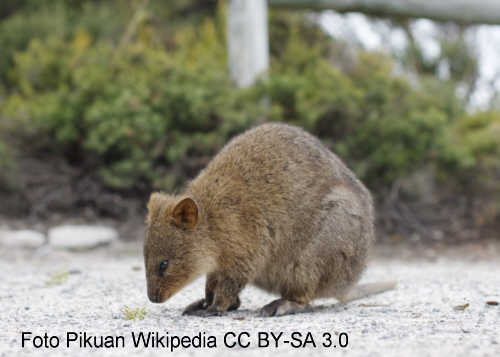Quokka (Setonix brachyurus)
description of the animal

Appearance
The quokka, a small marsupial belonging to the macropod family, measures between 40 to 54 centimeters in length and weighs between 2.5 to 5 kilograms. Characterized by a stocky build, the quokka's body is compact and well-suited to its arboreal climbing activities. Its fur, a coarse and thick pelage, is primarily a rich brown interspersed with hints of grey, which provides camouflage within its natural bushland habitat. This marsupial's face is notably expressive, endowed with large, round eyes that exude a lively and friendly demeanor. The so-called 'quokka smile'—formed by its small mouth and the way its cheeks puff out—is a distinctive trait that endears it to humans and has become synonymous with the species. Its small, rounded ears are set wide apart on its head, enhancing its innocent appearance, while the short, broad head features a black nose that is both prominent and tactile, aiding in foraging and navigation through dense underbrush. The quokka's muscular hind legs are proportionally shorter than those of other larger macropod relatives like kangaroos and wallabies, yet they are incredibly powerful and facilitate quick movement through their environment, whether bounding across open ground or making short, agile leaps into vegetation for safety or forage.
Distribution
The quokka is an endemic species to Western Australia, with its distribution tightly restricted to a few small islands and isolated pockets of the mainland. The majority of the quokka population is concentrated on Rottnest Island, where they are a significant draw for tourists. This island provides a sanctuary free from many of the predators that threaten their survival on the mainland, contributing to a stable and visible population. Another smaller but crucial population resides on Bald Island near Albany. On the mainland, quokkas are scattered and their presence more fleeting, found in bushland areas within the state's southwestern region, including parts of the Two Peoples Bay Nature Reserve, the Stirling Range, and other protected areas. These mainland habitats are often fragmented and subject to environmental pressures such as land development and the impacts of climate change, making the conservation of these areas vital for the species’ continued survival. The very specific requirements quokkas have for dense vegetation and fresh water sources dictate their presence and density within these regions, as they rely heavily on the availability of suitable habitat for shelter and food.
Habitat
The quokka has adapted to a range of habitats across its limited distribution, primarily thriving in environments that offer dense vegetation cover. On Rottnest Island, where the largest population resides, quokkas are found in tall grasses, scrublands, and thickets that provide ample cover from the harsh Australian sun and protection from predators. These habitats are characterized by a mix of shrubs, small trees, and grassy clearings which support their browsing diet. On the mainland, their preferred habitats are more diverse, including wetlands, coastal heaths, and forests with dense understories of ferns and shrubs. These areas are crucial as they provide not only food but also moisture, which is vital for their survival, especially outside the rainy season. Quokkas are particularly dependent on areas with abundant fresh water sources, as they need to drink regularly to supplement the moisture obtained from their diet. Environmental variability within these habitats, such as seasonal changes in plant availability and water sources, plays a significant role in their ecology, influencing patterns of movement, feeding, and breeding.
Behavior
Quokkas are intriguing animals with behaviors that reflect their adaptations to both island and mainland habitats. They are primarily nocturnal, most active at night when they forage for food, but in cooler weather or overcast days, they may be active during daylight hours, especially on Rottnest Island where they have few natural predators and are accustomed to human presence. Quokkas exhibit a high degree of sociability compared to other marsupials. They are often seen interacting with each other through gentle nose touches, grooming, and communal living in small, loose family groups, which helps in the avoidance of predators and increases the efficiency of foraging. Despite their friendly appearance, quokkas have a strong survival instinct. When threatened, they can leap and bound with great agility to escape danger, using their powerful hind legs to propel themselves into dense underbrush or towards safety. Their climbing abilities are also notable; although they are ground-dwelling, quokkas can climb small trees and shrubs to find food or evade threats. This versatility in movement helps them navigate their often rugged and bushy habitats. Communication among quokkas involves a variety of vocalizations and body language. They make soft clucking sounds as a form of communication within the group, especially from mothers to their joeys. When threatened, they may hiss or growl to signal distress or ward off attackers. The breeding season brings additional vocal behaviors as males compete for mates and females call to their offspring. The social structure of quokka populations, particularly on Rottnest Island, allows for a unique observation of these behaviors, as the animals are relatively habituated to human observers and may not flee from human proximity as quickly as other wild marsupials.
Diet
Their diet mainly consists of grass, leaves, and small plants. They are herbivores and have adapted to survive in their environment with limited water sources.
Reproduction
Quokkas have a breeding season, and after a gestation period, the female gives birth to a single joey. The joey then continues to develop in the mother's pouch for several months.
Threats
Quokkas face threats from habitat destruction due to human activity and predation by introduced species such as foxes and cats. Conservation efforts are in place to protect their population.
